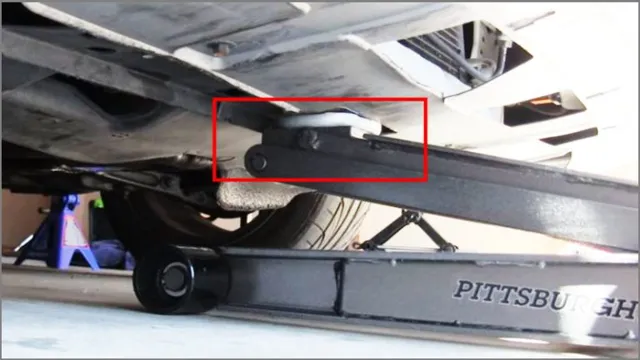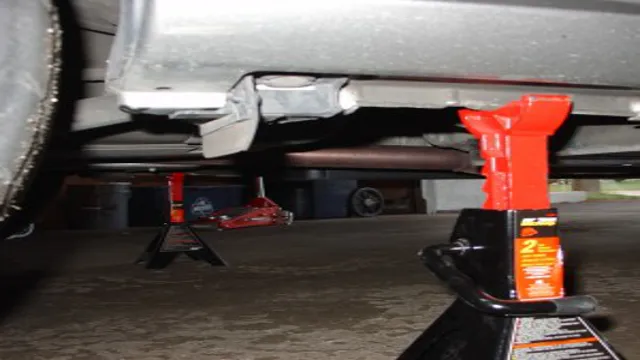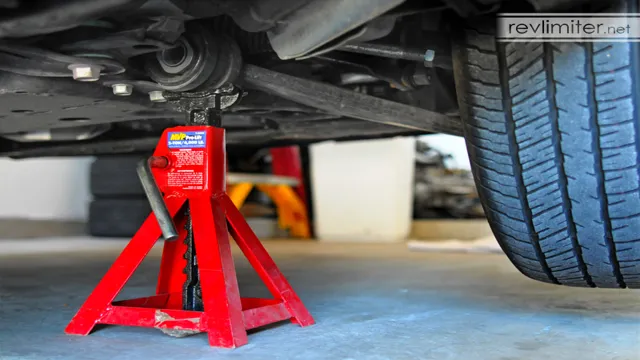Where Do You Place Jack Stands Under a Car? A Beginner’s Guide to Safe Lifting

Have you ever changed a tire or worked on the underside of your car and wondered where to place your jack stands? Placing jack stands on your car may seem like a straightforward task, but it is crucial to do it correctly to ensure your safety and prevent damage to your vehicle. Jack stands are essential tools that provide stability and support to your car while performing maintenance or repairs, and as such, they need to be placed correctly. Improper placement can cause the stands to slip or collapse, potentially causing severe injury or damage to your car.
In this blog, we will discuss how to place your jack stands correctly on your car. From finding the right areas to position them to ensuring they are secure, we will cover everything you need to know to perform safe and effective maintenance or repairs on your vehicle. So let’s dive in and learn how to keep your work under your car safe and enjoyable!
What are Jack Stands?
Jack stands are essential pieces of equipment when it comes to working on a car. They are used to support the car’s weight while you work on it, and they are typically placed under the car’s chassis or frame. To use jack stands, you need to first jack up the car using a hydraulic floor jack, and then place the stands in a secure position.
So, where do you place jack stands under a car? Firstly, it’s important to locate the car’s jacking points, which are indicated in the vehicle owner’s manual. These points are specifically reinforced to bear the weight of the car, so it’s essential to place the jack stands on these points. Once you’ve located the points, you will then need to place the stands under the car’s frame or chassis, and engage the locking mechanism.
This will ensure that the stands are securely supporting the car, and you can then begin to work underneath it with confidence. Remember to always use jack stands correctly, as failing to do so could result in serious injury or even death.
Definition of Jack Stands
Jack stands are essential tools used to hold a vehicle or any heavy equipment above the ground to perform maintenance tasks, repairs, or inspections. These stands typically come in pairs and feature a sturdy base with adjustable height positions that allow the user to lift any vehicle or equipment past the ground clearance level. Jack stands are great for secure repairs, changing tires, and performing oil changes as they offer superior stability and reliability compared to just using a tire change or hydraulic jack.
Using jack stands eliminates the need to prop up the car with unnecessary items that are less stable and reliable, ensuring safety from the vehicle’s weight. The most common type of jack stands includes pin-type, ratchet-type, and tripod-type models, each boasting unique features to suit different needs. Overall, Jack stands are crucial tools in any mechanic’s toolbox to ensure maximum safety and prevent any potential accidents while performing vehicle maintenance tasks.

Why Use Jack Stands?
Nowadays, it’s essential to have a reliable jack stand if you are planning to perform any car maintenance procedures. Jack stands are critical for keeping you safe and secure throughout your work process by preventing the car from falling on you. When placing jack stands under a car, you must identify specific points on the chassis of the car, called jacking points, that can safely accommodate the stand’s weight.
Each car model has specific locations where you should place the stands. Failure to place them correctly may lead to severe damage to your car or loss of life. Therefore, it’s vital to read your car manual and learn the appropriate locations that can accommodate jack stands safely.
Remember, safety should always come first when dealing with cars. In short, always ensure that you use jack stands and place them in the right spots to ensure your safety and avoid any damages.
Importance of Using Jack Stands
Using jack stands when working on a car is crucial for safety. While a jack can lift the vehicle, it is not designed to securely hold it in place for extended periods. Jack stands offer additional support, preventing the vehicle from falling in case the jack fails.
Don’t take the risk of trusting only a jack to hold a car up. It’s not worth the potential injury or damage to your vehicle. Additionally, always ensure that the jack stands are placed on firm, level ground and that they are rated for the weight of your vehicle.
By taking the extra step of using jack stands, you can ensure that your vehicle will remain in place while working on it, providing the necessary support to help you finish your project quickly and safely.
Steps to Placing Jack Stands on Your Car
When it comes to car maintenance, jack stands are an essential tool to have in your garage. But where do you place jack stands under a car? Firstly, it is important to find a flat and stable surface to park your car on before lifting it with a jack. Refer to your car’s owner manual for the specifically recommended locations to place jack stands.
Generally, they should be placed on the designated jacking points under the car’s chassis, which are usually located behind the front or rear wheels. Make sure the jack stands are secured and stable before releasing the jack. Additionally, be mindful of the maximum weight capacity of the jack stands and ensure it is suitable for the weight of your car.
Following these steps ensures the safety of both you and your car during maintenance tasks.
Park in a Level, Safe Location
When it comes to placing jack stands on your car, it’s important to park in a level and safe location. This means finding a flat surface, preferably on concrete, where you can safely place your jack stands without risking the car tipping over. Avoid parking on grass or gravel, as these surfaces are often unstable and can cause the jack stands to sink, making them unsafe to use.
Additionally, make sure the car is securely in park or neutral and apply the emergency brake before raising the car. Taking these steps to ensure a level, safe location will help prevent accidents and ensure a successful and stress-free experience placing jack stands on your car.
Identify Proper Jack Points of Your Car
When working on your car, it’s important to know where to properly place your jack stands to ensure safety. The first step is to identify the proper jack points of your car. Consult your car’s manual to see where your manufacturer recommends placing the jack stands.
Once you’ve identified these points, position the jack stand under the jack point and adjust the height. Make sure the jack stand is level and secure before placing the weight of your vehicle on it. Repeat this process for each jack point you plan to use.
Remember not to place the jack stands on any unstable or uneven ground, and always use the appropriate weight capacity for your car. By taking these steps, you can rest assured that your car is safely supported while you work on it.
Place Jack Stand Under the Jack Point
“jack stand placement” When it comes to placing jack stands on your car, the first step is to locate the appropriate jack point. This is typically located along the frame of the vehicle, and it’s important to make sure you’re using the correct one. Once you’ve found the jack point, carefully position the jack stand directly beneath it.
This is critical for ensuring proper support, as the jack stand needs to be positioned precisely in order to hold the weight of the car. Once the jack stand is in place, use the lever or crank to carefully raise it up until it’s snug against the underside of the car. Double-check that the jack stand is secure and hasn’t shifted before letting go of the jack.
By following these steps and placing the jack stand correctly, you’ll be able to work safely on your vehicle without worrying about it collapsing or shifting unexpectedly.
Adjust Jack Stand Height
“Adjust Jack Stand Height” When it comes to working on your car, safety should always be your top priority. Placing jack stands in the right position is crucial in ensuring that you won’t suffer from any accidents. In adjusting jack stand height, the first step is to find a level surface.
Then, take your floor jack and lift the car up to the desired height. Make sure that you place the jack stand under the designated lift point on your car and adjust the height accordingly. Once you have set the stand at the right height, lower the car onto the stand and give it a good shake to ensure the stand is stable.
Remember to avoid putting your hands underneath the car and always double-check to make sure that the jack stand is secure. Safety should always come first, and by following these steps, you can ensure a safe and successful time working on your car.
Repeat on the Opposite Side of the Car
Now that you’ve successfully placed the jack stand on one side of your car, it’s time to repeat the process on the other side. Make sure to lower the car down onto the stand gently, using the same steps as before. It’s important to ensure that the stand is securely in place and that the car is level before you start working underneath it.
Once you’ve repeated the process on the opposite side of the car, you can breathe easy knowing that your vehicle is safely supported by jack stands. Remember to always prioritize safety and follow all manufacturer instructions when using jack stands to protect yourself and your vehicle. With these simple steps, you’ll be able to safely elevate your car for all your maintenance needs.
Safety Tips When Using Jack Stands
When working on your car, it’s important to use jack stands in order to ensure your safety. So, where do you place jack stands under a car? The answer is crucial to ensuring the safety of both you and your vehicle. First, you need to locate the proper jack points on the car.
These points are usually marked clearly in the owner’s manual, and they are specifically designed to support the weight of the car on the jack stands. Once you have located the jack points, place the jack stands directly beneath them, making sure they are level and secure. It’s important to use jack stands on a solid, flat surface, and to make sure that the car is properly balanced on the stands.
This will help prevent the car from tipping or falling during repairs or maintenance. Remember, safety comes first, so always double check your work and take your time. By following these simple steps, you can ensure that you and your car stay safe while working on it.
Always Use Jack Stands on a Hard Surface
Jack Stands When it comes to working on your car or changing a tire, safety should always be your top priority. One of the essential tools you’ll need is a set of jack stands. Jack stands provide a sturdy and stable platform to elevate your vehicle and work safely underneath it.
However, it’s crucial to use them correctly to prevent any accidents. Always use jack stands on a hard and level surface as they can easily sink into softer ground and cause the car to fall from an unstable base. Additionally, make sure the jack stands are positioned correctly and are securely holding the weight of your vehicle before getting under it.
Proper use of jack stands can prevent injuries and save lives, so always follow these safety tips to ensure a secure and stable platform while working on your car.
Ensure the Car is Securely Supported by Jack Stands
When jacking up your car, safety should always be your top priority. Jack stands are essential to keeping your vehicle securely in place while you work on it. When using jack stands, it’s important to choose ones that are rated for the weight of your car.
Before you even start jacking the car up, you should make sure that the surface underneath the stands is level and stable. Once you’ve placed the jack stands in the correct position under the vehicle, it’s important to double-check that they’re securely locked in place. You can do this by giving the car a gentle shake, but never put your full weight on the vehicle while it’s on jack stands.
Keeping the car stable and secure on the stands is crucial to ensuring your safety while you work on it. Remember, accidents can happen, so always exercise caution and take all necessary precautions to avoid injury. Your safety is worth the extra time and effort it takes to properly support your car with jack stands.
Always Chock the Wheels
When using jack stands, it is essential to prioritize safety to avoid any accidents or injuries. One crucial safety tip is to always chock the wheels of your vehicle before lifting it with jack stands. Chocking the wheels involves placing a wedge or block behind the wheels to prevent the vehicle from rolling or moving while it’s lifted.
This provides an extra layer of safety and stability. Always ensure that the chock is in place before lifting the vehicle. Additionally, ensure that you place the jack stands on firm and level ground, use the appropriate jack stand weight capacity for your vehicle, and follow the manufacturer’s instructions.
By following these safety tips, you can prevent any untoward incidents and ensure a safe lifting process.
Never Work Under a Car without Jack Stands
Jack Stands When working on a car, it’s natural to want to get as close as possible to what you’re working on. However, this can be a dangerous mistake that many DIY mechanics make. Never work under a car without jack stands.
They are a crucial tool for keeping you safe when working on a vehicle. You might think that using the car’s hydraulic system to prop it up is enough, but this method is unreliable and can cause accidents. Using jack stands provides stability and security when you’re working underneath a car.
Safety tips when using jack stands include properly positioning them, ensuring that they are the right size, and double-checking that they are secure before starting work. Always work with a partner, so they can steady the car while you work and call for help if necessary. Remember, never work under a car without jack stands.
Your safety is precious, and precautions like these can prevent accidents and save lives.
Conclusion
So, to sum it all up, when it comes to placing jack stands under a car, the key is to always prioritize safety over convenience. No matter how skilled or experienced you are, cutting corners or taking shortcuts in this area is simply not worth the risk. So next time you work on your car, make sure you do it properly and ensure that your jack stands are placed securely, so that your car stays in place and you can work on it with peace of mind.
Remember: safety always comes first, unless you’re playing chess, then it’s all about those clever moves!”
FAQs
What is the purpose of jack stands when working on a car?
Jack stands provide additional support and stability to the car when it is raised by a jack.
Where should the jack stands be placed under a car?
Ideally, jack stands should be placed on a firm and level ground underneath the vehicle’s recommended jacking points.
What is the maximum weight capacity of a typical jack stand?
The weight capacity of a jack stand varies depending on its size and model, but a typical one can support anywhere between 2 to 6 tons.
Can I use bricks or cinder blocks instead of jack stands?
It is not recommended because bricks or cinder blocks may not provide enough stability and may slip or collapse, posing a safety risk.
Can I use only one jack stand to work on my car?
It is not recommended to use only one jack stand because it may not provide enough stability and can tip over, causing potential harm to the car and the person working on it.
Can I reuse an old or damaged jack stand?
It is not recommended to use a damaged jack stand as it may not provide the necessary stability and can fail, causing potential harm to the person working on the car.
How do I properly store my jack stands when not in use?
Jack stands should be stored in a dry and cool place, preferably on a shelf or rack, away from any heat sources or chemicals that can corrode them.



